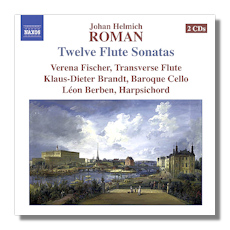
The Internet's Premier Classical Music Source
Related Links
- Roman Reviews
- Latest Reviews
- More Reviews
-
By Composer
-
Collections
DVD & Blu-ray
Books
Concert Reviews
Articles/Interviews
Software
Audio
Search Amazon
Recommended Links
Site News
 CD Review
CD Review
Johan Helmich Roman

12 Flute Sonatas
- Sonata for Flute #1 in G Major
- Sonata for Flute #2 in D Major
- Sonata for Flute #3 in C minor
- Sonata for Flute #4 in G Major
- Sonata for Flute #5 in E minor
- Sonata for Flute #6 in B minor
- Sonata for Flute #7 in G Major
- Sonata for Flute #8 in A Major
- Sonata for Flute #9 in C Major
- Sonata for Flute #10 in E minor
- Sonata for Flute #11 in G minor
- Sonata for Flute #12 in D Major
Verena Fischer, transverse flute
Klaus-Dieter Brandt, baroque cello
Léon Berben, harpsichord
Naxos 8.570492-93 DDD 2CDs: 75:11, 70:42
Johan Helmich Roman commonly is regarded as Sweden's first important home-grown composer. He was born in Stockholm in 1694, and by the time that he was seven he was performing for the court of King Charles XII. In his twenties, he was sent to London to continue his musical education, and there he met Handel – Handel's influence stayed with him for the rest of his life – and studied with John Christopher Pepusch, co-composer of The Beggar's Opera.
When he returned to Stockholm in 1721, he was named Assistant Kapellmeister to the court, and then, six years later, Kapellmeister. In the latter role, he set out to improve the standards of the court orchestra, and he also composed. His most famous work is what is known as the Drottningholm Music, a suite of orchestral movements composed for the 1744 wedding of Princess Lovisa Ulrika and Adolphus Frederik. Despite its fame, it was not published in Roman's lifetime, however. Roman's only works to be so favored are the twelve flute sonatas recorded here.
Published in 1827, and dedicated to Queen Ulrica Eleonora, these sonatas were intended neither for beginners nor for very advanced players. In other words, what Roman was doing for the Swedish court orchestra he also was doing for everyday Swedes: building on a foundation to raise their general level of technical skill.
Each sonata is in between four and six movements; many of these are in the style of dances. Like Handel (and Baroque composers in general), Roman reused his music, so movements from these sonatas reappear in altered form in later works. Other composers appropriated this music also – again, very much in the spirit of the times. In these multiple ways, Roman's music diffused into the Swedish culture.
Handel would not have been ashamed to write these sonatas, which are remarkable for their variety and for the high level of inventiveness that Roman showed in their composition. They are not in a "learned" style but emphasize tunefulness, grace, and what a good amateur flutist could make sound attractive on his or her instrument. Neither the flutist nor the listener is likely to be bored. (The continuo players play a more subsidiary role, of course.) This is perfect music to enjoy on a Sunday morning with your feet up and a cup of coffee by your side.
Verena Fischer specializes in music from this era. Between 1996 and 2006, she was principal flutist with Musica Antiqua Köln, and she has recorded music by Telemann and Wilhelm Friedemann Bach for Deutsche Grammophon's Archiv label. She uses a period instrument here, and she plays it with assurance and style, bending the pitch of sustained notes to good expressive effect. Brandt and Berben are unobtrusive but not unimaginative. Apparently this is the only recording to include all twelve sonatas.
[About twenty years ago, the Proprius label released two CDs containing all twelve sonatas played by Christoph Huntgeburth, Olof Larsson, and Eva Nordenfelt (PRCD9019 & PRCD9020).]
Copyright © 2009, Raymond Tuttle




















